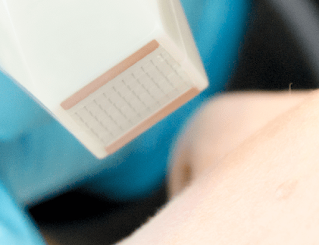Fractora is a cutting-edge skin resurfacing method that uses a bipolar radio-frequency fractional technique to achieve significant results. Fractora significantly improves the appearance of the skin and wrinkles by fractionally excising the surface and reconstructing deeper tissue. Fractora distributes bi-polar radio frequency to the dermis through an arrangement of pin electrodes, which are positioned in a circular pattern.
You can apply Fractora anywhere on your face or body where skin restoration and rejuvenation are needed. Treatment is appropriate for parts of the face and body that demonstrate ice-pick acne scars, wrinkles, or discoloration. Fractora is also a good treatment for acne that is still active.
Prior to Fractora therapy, the targeted area is usually desensitized with a dermal or local anesthetic. The Fractora handpiece then stamps the affected areas. Treatment sessions are often less than an hour. After cleansing and coating the treated area with a fine layer of antibacterial ointment, a patented skin rejuvenation cocktail is applied. In order to achieve the best outcomes, some patients choose to follow up their Fractora treatment with PRP therapy.
The fractionated radiofrequency radiation present in Fractora has been scientifically demonstrated to be an effective wrinkle reduction treatment. A sequence of micro-pins is used to rejuvenate and rebuild the skin in a minimally invasive manner, resulting in remarkable outcomes with little or no downtime for the patient. As an added benefit, the Fractora micro-pins can be preferentially applied with silicone gel, allowing for the treatment of all skin types cautiously and preventing the risk of thermal damage to the upper skin, as well as the reduction of the risk of hyperpigmentation or hypopigmentation, which is commonly seen with traditional lasers such as CO2.

The Fractora treatment is executed in an outpatient setting under a local anesthetic. It causes very minor discomfort, redness, and swelling. The procedure usually takes an hour to complete. For a few days after the procedure, there may be some slight redness and swelling. On the first day, the skin is normally treated with an antibiotic ointment, followed by an emollient as required. Following the surgery, patients are advised to avoid direct sunlight for a few weeks after the procedure to avoid sunburn.
Fractora Pros
Fractora is for people who want to tighten their skin, reduce wrinkles, and improve the texture of their skin, so they can look younger. Because of its fractional facial rejuvenation, it is one of the most effective procedures for decreasing the marks of the aging process. The face, body, and extremities are all suitable areas for the application of this procedure. Fractora is also beneficial for those who require acne scar treatment.
Fractora is suitable for all skin types, including those with advanced signs of aging. The majority of laser treatments may not be an option if you are Hispanic, Asian, or African-American and have a darker skin tone. Fractora skin treatment, on the other hand, has a far lower chance of producing pigmentation on darker skin tones, making it a viable option.
The benefits of Fractora are as follows:
- It is a non-surgical treatment that tightens the skin.
- Multiple skin issues can be treated with minimal ablation using this procedure.
- Up to a 50% reduction in the appearance of acne scars is possible with this treatment.
- There is a low chance of post-inflammatory hyperpigmentation.
- Downtime will be limited to 4 - 5 days.
Fractora Cons
When you get a Fractora treatment, your skin may seem red, and it will be sensitive. The most common side effects are mild swelling, itching, light bruising, and tightness. There is no downtime necessary, although most patients choose to stay at home for a few days to allow their apparent side effects to reduce more. When a light Fractora treatment is performed, skin redness will typically disappear within three days, however, skin redness following a deeper Fractora treatment may take as long as ten days to disappear.







0 Comments
For comments please reply here.......